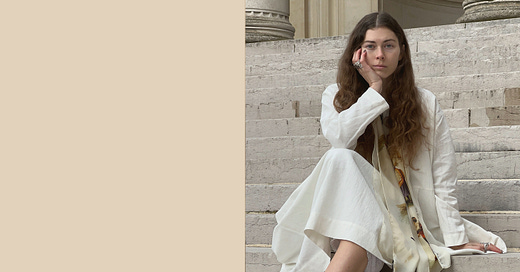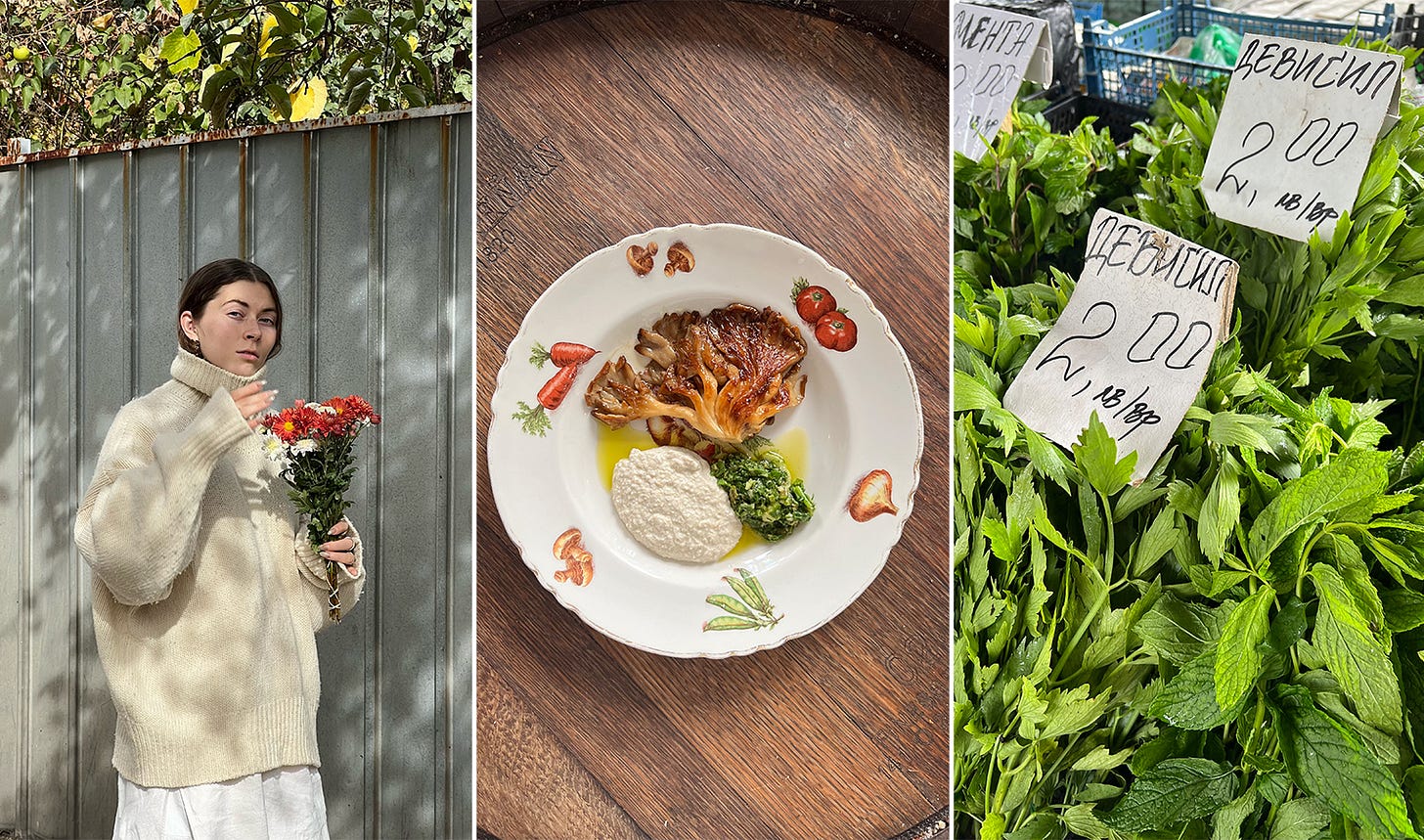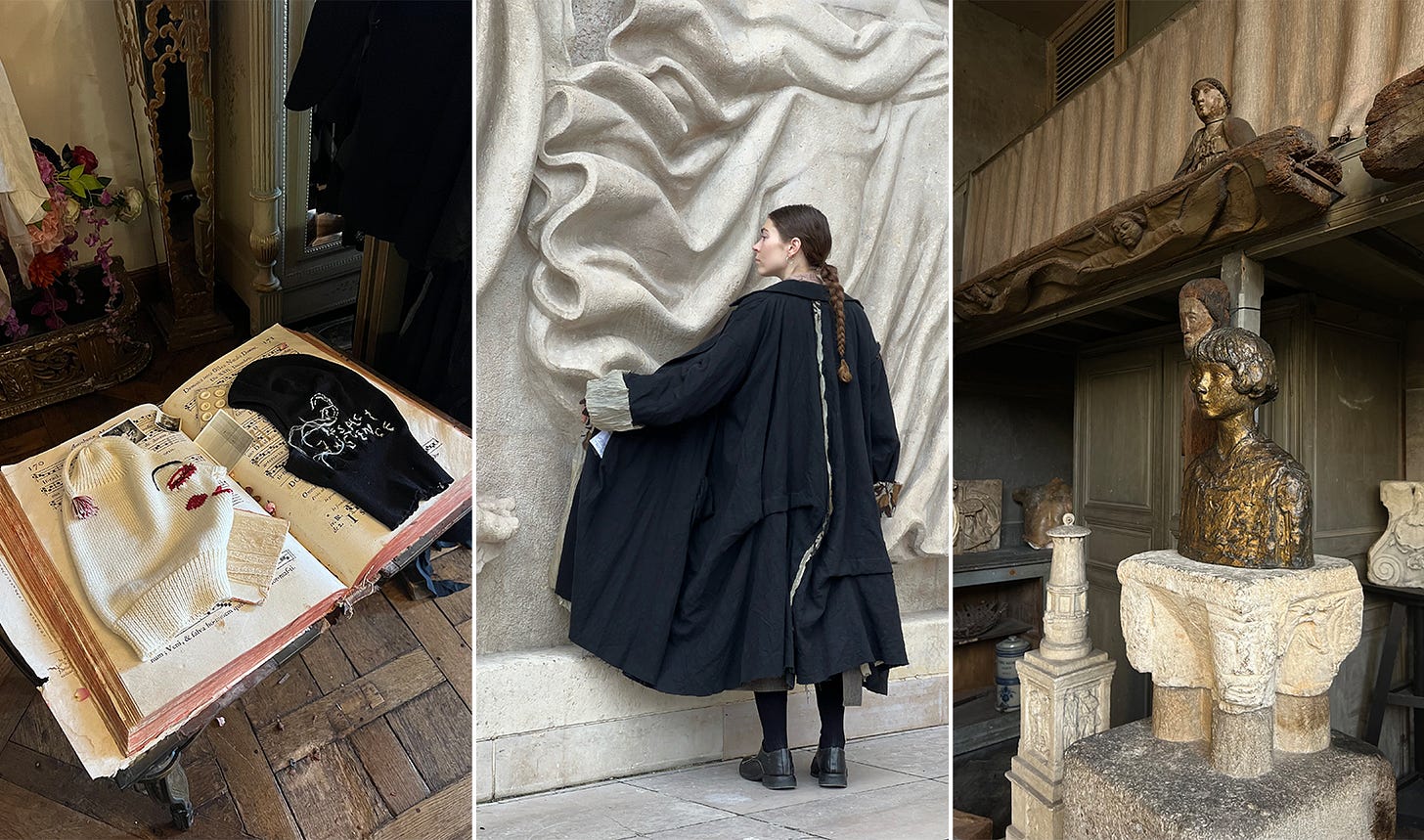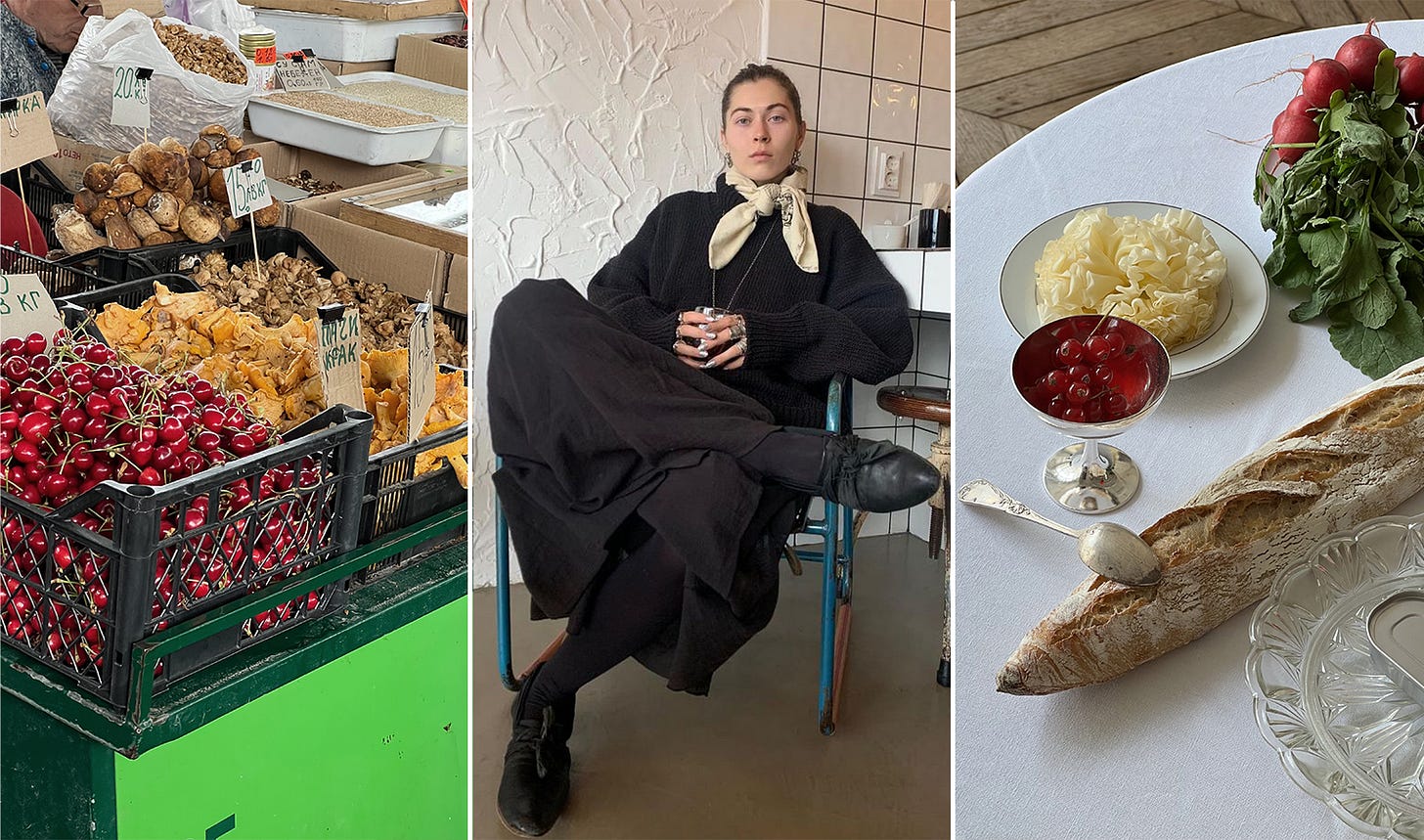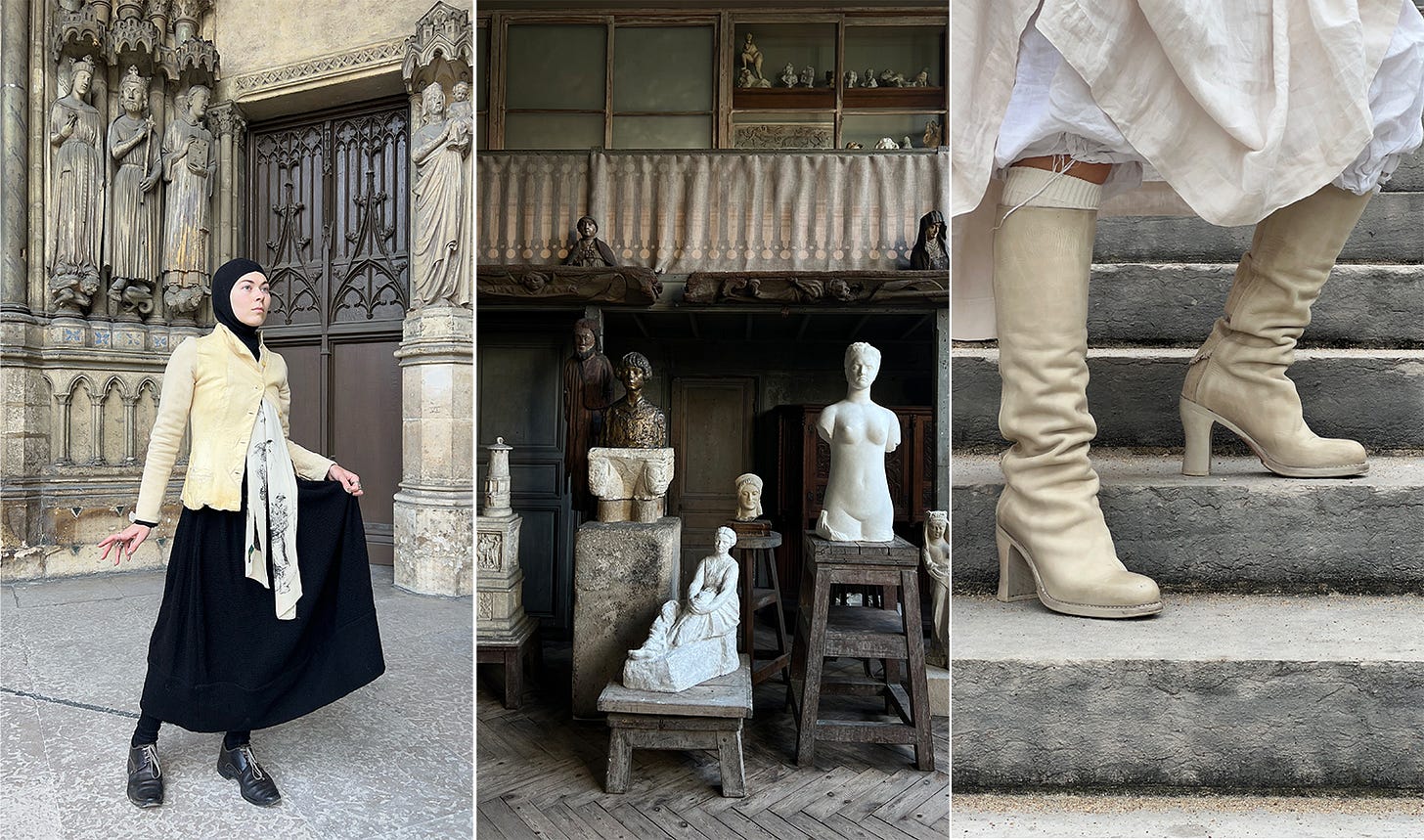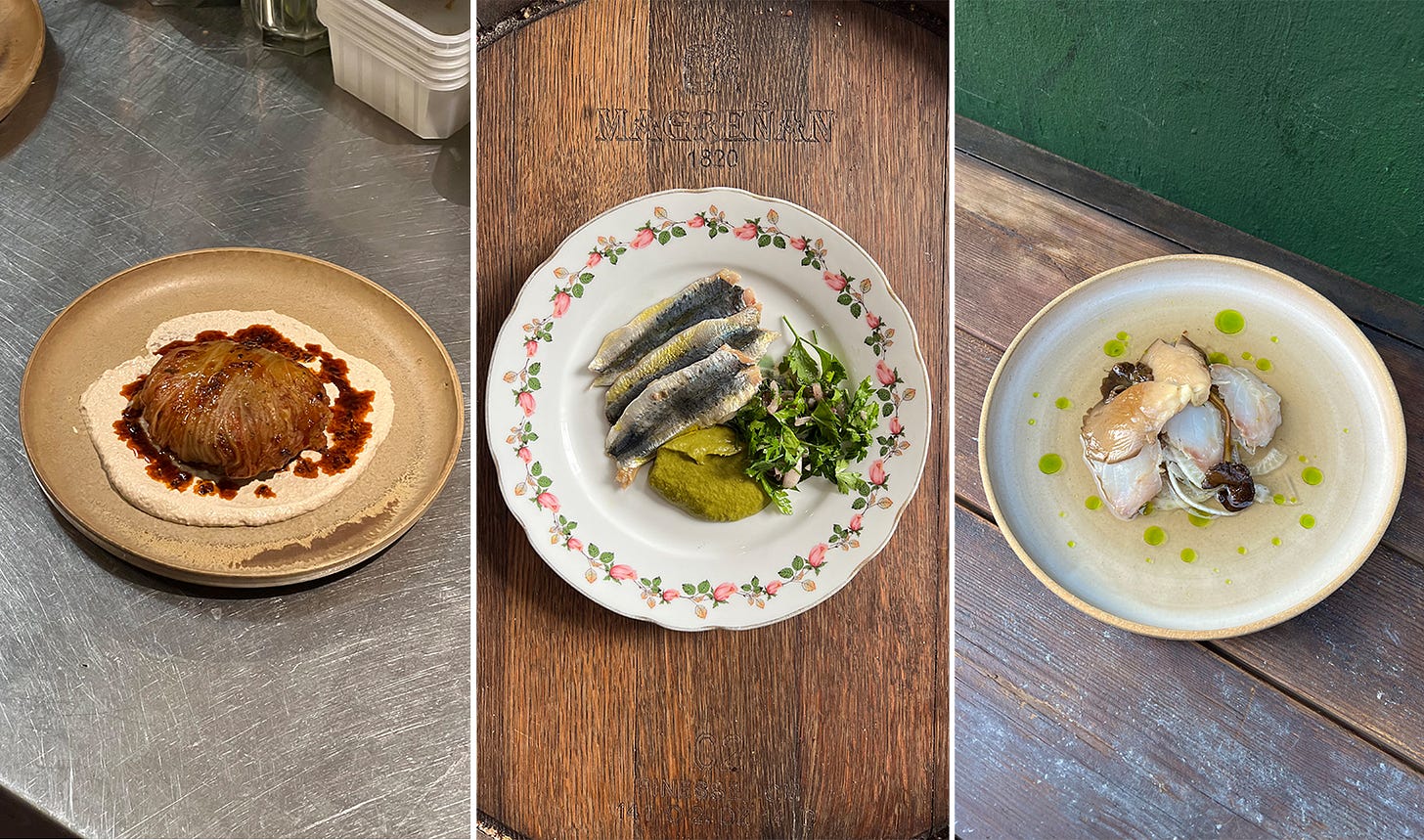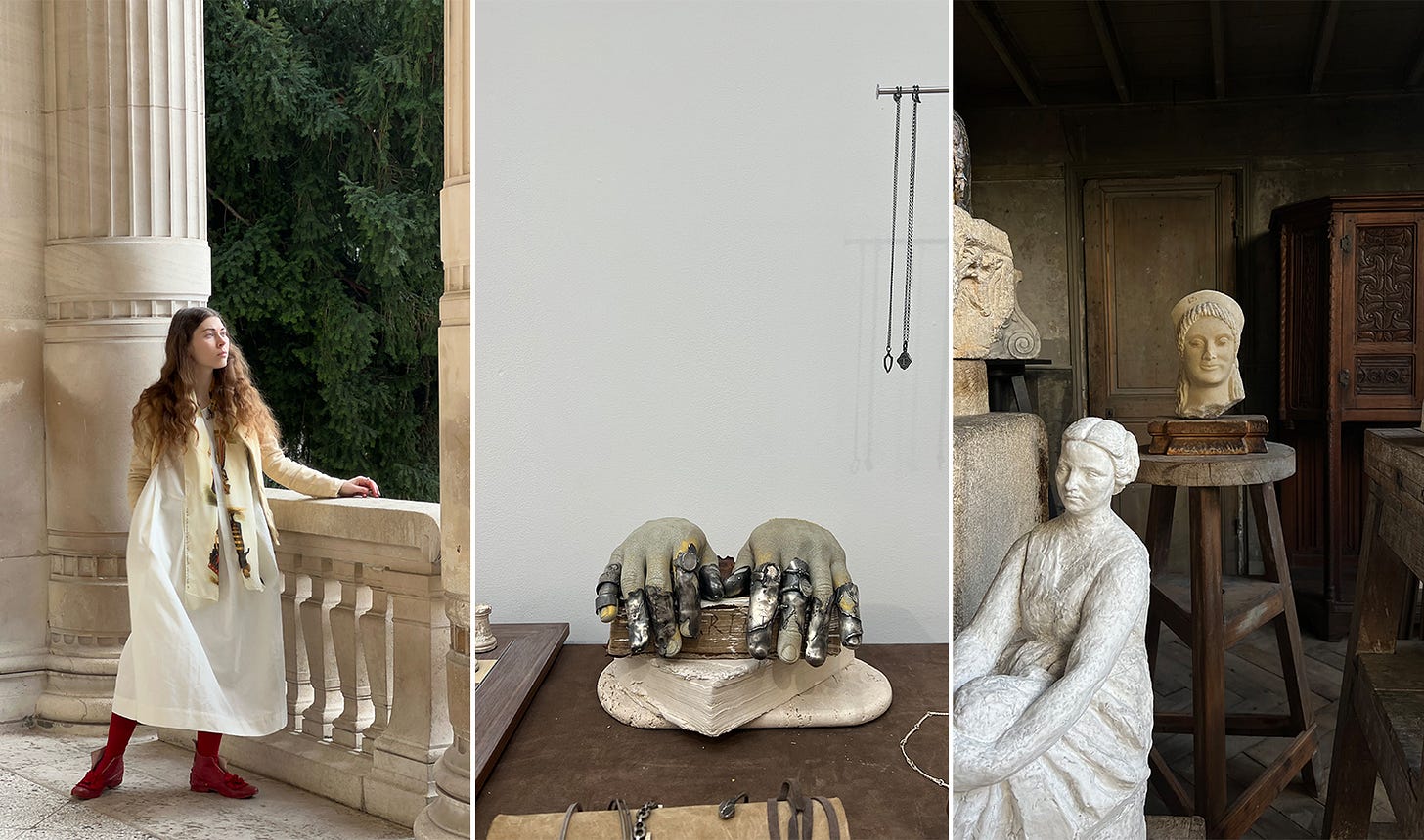Visual Narratives: Exploring the Stories Behind Evelina Dimova's World
In Conversation with Eva Dimova, where we discuss Artisanal Fashion, Hidden Parisian Gems, Châtelaines, & Unfiltered Self-Expression
Introducing Eva Dimova, Where the Intersection of Sustainable Style, Cultural Curation, & Cuisine Meet
Hi Evelina, and welcome to Land Journals. You have such a unique visual style, encompassing something that looks very modern, yet feels almost ancient, with references and nods to fine art and literature. This viewpoint carries over to your interpretation of the world around you, which goes far beyond visual curation. One that delves into your perspectives on our online presence and impact, observing life and the ethics of storytelling, specifically art and design edits, your curated food experiences, sustainability, and then your distinctive take on style and fashion. Where all of these are always guided by your very authentic and non-trend-led aesthetic. I’d love to share some of your insights on Land Journals about what your particular world looks like to inhabit so that we can discover more about your creative life.
Rachel: Can you describe a typical day for you, are there any daily rituals or practices that you do, that help you to develop your ideas and creativity?
Eva: I don’t think I have what you’d call ‘a typical day’ purely based on the freedom that freelance work allows. I’m not necessarily a morning person, so depending on what I’m currently undertaking as a project, for example, fashion week as opposed to a restaurant residency, I could wake up anywhere between 7:30 and 10:00 am. Though I always start the day off with the worst beverage possible: a black coffee on an empty stomach.
When it comes to creativity, I don’t necessarily practice it as far as conscious efforts are concerned, but I have probably curated my everyday life in a way that has become an inherent part of it. The usual cliches apply though: reading books, and watching films (that are not what online platforms–not even MUBI, offer). Visiting art exhibitions does change one’s (mine) outlook on things and their creative output. Whether in a more obvious way as one begins to incorporate them into their life, or in a subtle, but deeper way, once they realise that it is not the pure visuals and direct parallels that they need to apply, but the underlying human ideas.
Rachel: Where do you like to go to find inspiration, what are your practices for finding ideas and then developing them further?
Eva: It greatly depends on whether it’s inspiration when it comes to food, to fashion or just inspiration to curate a pleasant, aesthetically pleasing and philosophically engaging living experience for myself. As I said, I do not try to look for inspiration consciously which is probably a privilege that is not granted to everyone. It can be, but one needs to invest time that they might not be lucky enough to have, to fully assimilate the things they are consuming beyond their surface level first.
I usually ‘look’ for inspiration in the past. There is beauty and a bit of a challenge from our modern perspective in the limitations, or the lack of technology of times past imposed on the final output, be it cooking only with produce that is in season or only wearing a few items of clothing, often made of natural fibre.
Of, course, I am not necessarily opposed to the abundance of inspiration that social media can bring me; I just tend to not seek it from those who have set out to give inspiration, but rather through observing individuals who are passionate about something, that might have until then, been outside of my scope of expertise.
Rachel: Do you have any particularly loved fashion designers? What is it that you like about them, what draws you to them, and why?
Eva: I have my pantheon of favourite designers and tend to have a few of them rotate in and out of my top spots, but the two designers that I’ve been wearing almost religiously for the past 10 years are probably Paul Harnden and Elena Dawson. Alongside their work, I also enjoy genuine Victorian and Edwardian-era garments. I’d say the inspiration from those times past especially with a strong nod to heritage English craftsmanship, mixed with the whimsical twist of both of them, is what initially pulled me in and continues to draw me to what they create.
Rachel: What are the main inspirations behind some of the looks that you put together, are they spontaneous or well-planned?
Eva: There are outfits that I plan and then there are outfits that I spontaneously put together and end up loving. There are, of course, outfits that I plan and outfits that I spontaneously put together, only to realise that they don’t really work. Thankfully, it seems the first case is more common. When it comes to inspiration, there exist two types of outfits: those that just ‘seem right’ and are nothing beyond an aesthetic combination of colours, textures, and shapes, and those that help me channel a character. The first type seldom has any deeper meaning or inspiration behind it, other than me knowing my wardrobe and what it can give me in terms of a playing field… or you could, especially in this era of hyper branding yourself, say that the inspiration for those outfits is myself, Evelina, a sort of ‘Evelinacore’, if you will. The inspiration for the second type of outfit is as simple as it sounds: it can be a specific character or an archetype, sometimes even an existing person from a previous era that I’ve seen pictures of or heard stories about.
Rachel: Do you have a style ethos, and if so, how would you describe it?
Eva: As much as I love clothes and dressing up, I also feel that we sometimes try to put too much emphasis on them where there is none to be had. My ethos is simple, not one usually put into words, but if I were to try and phrase it somehow, it’d probably be something along these lines:
Staying true to myself, whatever that may entail.
Seeking out the most sustainable option for buying something without thinking first and foremost of the best way to brand myself as ‘sustainable’, but instead taking my time to properly assess just how sustainable a purchase I’ve made actually is (eg., buying second-hand clothing online and having the item, packaged in three pieces of plastic, flown from hallways across the globe).
Supporting creatives who incorporate heritage techniques into their production, regardless of the adjacent name and status (eg., equally supporting big name brands–or, as big as they can be considered in the small niche that is ‘artisanal fashion’, smaller brands, and, that one grandmother that sells her knitted socks by the road, leading to her village in the Bulgarian mountains).
Rachel: How has your style evolved over the years, have you always been inspired by the same things, or has this changed over time?
Eva: I have always been drawn to clothes and style as a form of self-expression, ever since I was a child. I have no memories of engaging with mainstream–be it ‘high’, or ‘low’–fashion or looking up to the industry and its output when I was younger, but my fascination lied, and still does though, in a different way, in the counterculture.
My style journey started when I was around twelve years old, Vivienne Westwood was probably the first designer whose work I was consciously aware of and drawn to. Throughout my teens, my biggest inspiration ended up being Japanese street fashion with its abundance of styles, separate or mixed into one amalgamation of stylistic freedom. Through that, Comme des Garçons was the next brand whose world I fell in love with–a brand that has been in my active rotation to this day. Though it admittedly took me the better chunk of my life to figure out how exactly it fits with my style.
My 20s were mostly a path of accumulation more so than a path of discovery. After starting my heavily designer-dependent fashion journey, as many do, through the consumption of works of avant-garde designers such as Ann Demeulemeester and Rick Owens in the early 2010s, I quickly found that while I love their work (and I still wear it to this day), there is a style that resonates with me more: that which has now come to be known as ‘artisanal fashion’.
It’s been 10 years of slowly building a wardrobe and letting go of rigid preconceived notions of what the ‘right’ and ‘wrong’ ways of wearing this style are. While I do not want to lie, by saying that my style is not heavily designer-dependent, I have learned to embrace other channels of sourcing my garments and accessories: non-brand handicraft, vintage, and antique items. The incorporation of these has made me finally be able to say that I do have, to an extent, what you’d call ‘personal style’ and feel fully comfortable in it.
Rachel: Who else’s style do you hold in high esteem, and why?
Eva: I seldom look up to other (real) people’s styles, those existing purely in the fantastical realm of films, video games, and books are a whole other story. I also don’t consume style-adjacent content online, both because it does not interest me that much, and because I willingly do not wish to be affected by it, in both the good (inspiration), and the bad (covetability) ways that it potentially could.
The one person, though, who always comes to mind when I hear the word ‘style’, and especially personal style, which is something extremely rare, is my friend Masha. I have never seen anyone dress the way that she does and everything she puts on feels so extremely personal to her as a human. She is unapologetically herself and this is the only criteria based on which I wish to rate anyone’s style.
Rachel: You mention that being sustainable is important to you, how do you practice this in your day-to-day life, is there any advice you can impart on refining our impact on the planet?
Eva: I am by no means a perfect example, but as a firm believer in the mantra that “we don’t need a few people to be perfect, but everyone to be a little better”. I will share my advice, which can actually be applied to anything, not only sustainability – that when it comes to trying to be more sustainable: think things through and internalise the conclusions.
We have been conditioned, partly by social media, partly by the increasingly competitive state of the capitalist hellscape in which we exist, and partly by the intersection of two–to believe that there is not only a right way of doing things but a perfect state that is to be reached; and reached as quickly as possible for one to not feel as a failure. In order to do that, as it is no easy task, but also, as everything is now a product to be sold, including ourselves, our lifestyles, and our philosophies/guides on how to do it exist, as do, of course, consumables that will help one buy their way into sustainability.
To be less broad, I will give the consumption of second-hand clothing as an example: influencers urge people to prioritise buying pre-loved and that in and of itself is wonderful, but many people fail to understand that not all second-hand consumption is created equal. Procuring an item a month by visiting local clothing swaps does not have the same impact as buying 10 items online and having them shipped to you, as I already mentioned. The latter, though, is still preferable to buying 10 new fast fashion items and having them shipped from halfway across the globe.
Real sustainability starts there: thinking your actions through and internalising your conclusions, transforming them slowly into better practices that are not there to serve your ego, but the planet.
Rachel: Could you tell us about some of your favourite haunts in Paris, and what makes them special to you?
Eva: One place that always comes up in my recommendations to people, is Musée Bourdelle–Antoine Bourdelle’s atelier-turned-museum in the 15th arrondissement. Specifically the one room at the heart of it. Its walls are a soft grey, filled with an assortment of antique wooden furniture and sculptures, both made by the artist himself and coming from what I can only assume was his personal collection. On days when there are no school groups visiting, it’s extremely quiet, the only thing you hear being the soft squeaks of the floor under your own feet as you make your way around.
Rachel: What would be an ideal meal for you, or menu? What would it contain and where would it be if you could imagine it to be anywhere of your choosing?
Eva: There is no one single ideal meal. Meals are greatly dependent on all surrounding circumstances, but there is one meal I will always remember eating and thinking - This is perfection': charcoal grilled sardines wrapped in fig leaves, cooked by the wonderful chef Justine Pruvot, during her residency at a restaurant in Arles in the South of France a few years ago. Also, a hard-boiled egg with salt that I had packed myself and ended up eating sitting on the ground and looking at the snow quietly fall in the Alps; alone but for a lone dog looking at me from one of the yards of the village I had sat down next to.
Rachel: Do you have a favourite piece of design, and why?
Eva: It’s like asking a mother to pick a favourite child! Though I think one of my favourite design concepts in existence is Victorian châtelaines–little belt hooks worn at the waist with a multitude of chains, each ending with a useful appendage, such as watches, keys, or scissors. I’m quite fond of the silver coin purses that would often be on one of these appendages, too.
Rachel: Do you have an artist or piece of art that you love, what do you appreciate about them or their work?
Eva: There’s way too many to list, especially considering the arts are such a vast area; visual, literary, auditory and performance. In the more ‘classical’ realms, as I think we tend to think of visual arts first and foremost when asked about artists and/or art pieces, is Anselm Kiefer, someone whose work never fails to make me emotional. One piece that recently stood out to me, whether because of the piece itself or because of its placement (on display at the Hamburger Bahnhof in Berlin), was ‘Lilith am Roten Meer’ (1990), based on the myth of Lilith, first wife of Adam, who was punished for demanding equality by having a hundred of her children be killed every day. While I cannot confirm the claim that it is intentionally meant to evoke the holocaust, with Kiefer’s work, it is not beyond the realm of a very strong possibility–it is an allusion that can be viscerally felt as one looks at the tableau.
Rachel: And what are you reading right now? Or what would you recommend to read?
Eva: I’m currently rereading Ursula K. Le Guin’s ‘The Left Hand of Darkness’ which is a book that I would recommend to anyone, regardless of whether they enjoy science fiction (for it is not necessarily a very orthodox example of science fiction, classic as it may be) or not. My go-to book for recommendations, though, and the book I’ve read (now not so) recently that has managed to stick with me beyond reason is Susanna Clarke’s ‘Piranesi’. I have never been so viscerally transported to a place quite like I was when reading this book; I can close my eyes and still vividly imagine those great halls. It might now be too well known to be considered a proper hidden gem of a recommendation, but if you’re like me and stray away from things deemed ‘too popular’, let me be the one to tell you this. Read it. Regardless of what you think you’ll think of it, read it.
Rachel: What would be your dream destination to visit, have you been there yet?
Eva: My dream destination is as cliche as they come, but it is one where I have been and have even lived before, Japan. It is a country that has, for better or for worse, consciously and un-subconsciously, shaped the trajectory of my life and a place that I will never tire of exploring, discovering and rediscovering, both it and myself through it.
Rachel: Can you give us some style tips? How can people learn to curate an authentic look, that’s true to who they are, as you do?
Eva: You don’t need to have a strong unique look. And that is okay. To me, that somewhat controversial opinion is the first step towards finding a style that is true to who you are. If you are meant to dress in a way that deviates from the norm, you will know it–and you will know no rest until you achieve a style that is a true representation of who you are as a human.
Some people would argue that in order to know that you want to adopt a certain style, you’d have to know that a style like that exists, so exposure to outside stimuli is crucial. While that is true to an extent, and while I absolutely always recommend exposing yourself to as many forms of art as possible, because art, alongside nature, truly is the biggest inspiration for everything–I believe that a drive to express oneself through style is more inherent than we give it credit for. How exactly that drive will evolve and what it will manifest in, will of course depend on the outside stimuli.
Rachel: Is there something that you’re currently working towards?
Eva: Currently and always, a purer form of self-expression and a way to sustain my life through it to a greater extent than I do now.
Rachel: If you were a song, what would it be?
Eva: I think the lullaby from Pan’s Labyrinth, one of my favourite movies—soft, somewhat strange and eerie.
Rachel: What’s your astrology - sun, moon, rising?
Eva: Aquarius sun, Pisces mood, and Capricorn rising. It truly took me looking into my moon and my rising sign to figure out why these un-Aquarius-like traits I have were so prominent (and now they all make sense; alongside, of course, being a very textbook eccentric Aquarius which I’ve always loved about myself and which is probably the reason why I ‘bought into’ astrology in the first place).
Rachel: What is the one truth in life that you wish everyone knew?
Eva: You are enough.
The Land Journal Interviews
Welcome to the first in a series of curated interviews on LAND Journals, with the handpicked people who inspire me the most. These are the individuals who have a unique perspective on life and bring something entirely new into the World. They challenge my viewpoint and rouse my thought processes, bringing an entirely new interpretation of life, and, I’m hoping that their insights will do the same for you. These truthful conversations are important, unfiltered, and mostly unedited. So, if you haven’t already, subscribe for more deep dives into the lives of some of the most fascinating people around.
Oh, and before you ask, my astrological line-up is is; Cancer Sun, Aquarius Rising, and Leo Moon.
If you’d like to be considered for an interview, get in touch via email: hello@rachelholland.co.uk


